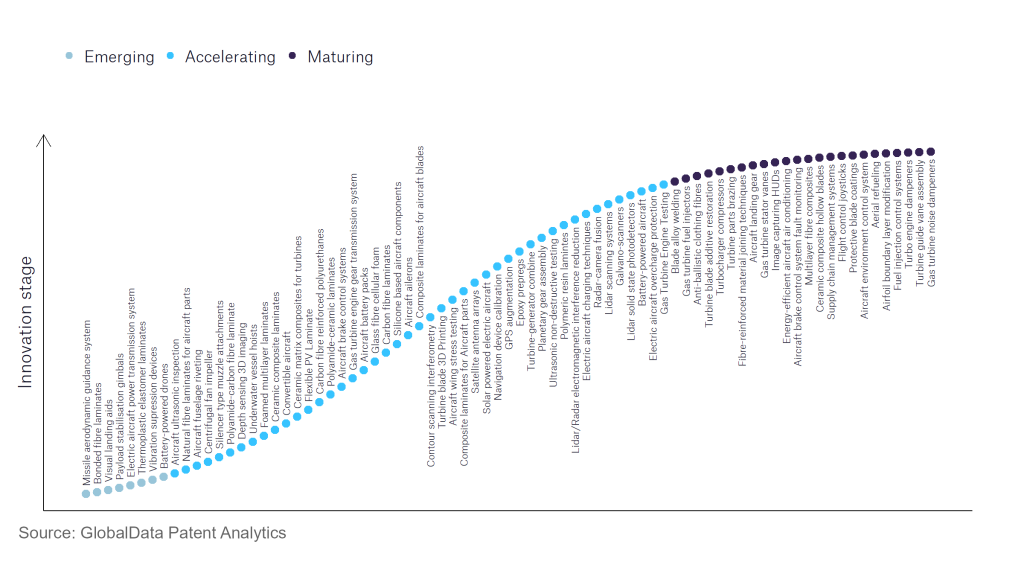The aerospace and defence industry continues to be a hotbed of innovation, with activity driven by the uptake of advanced technology, and growing importance of technologies such as hypersonics and advanced materials. In the last three years alone, there have been over 174,000 patents filed and granted in the aerospace and defence industry, according to GlobalData’s report on Innovation in Aerospace, Defence & Security: Radar-camera fusion. Buy the report here.
However, not all innovations are equal and nor do they follow a constant upward trend. Instead, their evolution takes the form of an S-shaped curve that reflects their typical lifecycle from early emergence to accelerating adoption, before finally stabilising and reaching maturity.
Identifying where a particular innovation is on this journey, especially those that are in the emerging and accelerating stages, is essential for understanding their current level of adoption and the likely future trajectory and impact they will have.
180+ innovations will shape the aerospace and defence industry
According to GlobalData’s Technology Foresights, which plots the S-curve for the aerospace and defence industry using innovation intensity models built on over 262,000 patents, there are 180+ innovation areas that will shape the future of the industry.
Within the emerging innovation stage, bonded fibre laminates, thermoplastic elastomer laminates, and vibration supression devices are disruptive technologies that are in the early stages of application and should be tracked closely. Centrifugal fan impellers, ceramic composite laminates, and gas turbine engine testing are some of the accelerating innovation areas, where adoption has been steadily increasing. Among maturing innovation areas are protective blade coatings and blade alloy welding, which are now well established in the industry.
Innovation S-curve for the aerospace and defence industry

Radar-camera fusion is a key innovation area in aerospace and defence
Both cameras and radars collect and analyse data about the surrounding environment. Cameras do this by collecting information through light, whereas radar does this through the emission of radio waves. Cameras and radar data can be fused in order to provide a more detailed picture about the surrounding environment.
GlobalData’s analysis also uncovers the companies at the forefront of each innovation area and assesses the potential reach and impact of their patenting activity across different applications and geographies. According to GlobalData, there are 50 companies, spanning technology vendors, established aerospace and defence companies, and up-and-coming start-ups engaged in the development and application of radar-camera fusion.
Key players in radar-camera fusion – a disruptive innovation in the aerospace and defence industry
‘Application diversity’ measures the number of different applications identified for each relevant patent and broadly splits companies into either ‘niche’ or ‘diversified’ innovators.
‘Geographic reach’ refers to the number of different countries each relevant patent is registered in and reflects the breadth of geographic application intended, ranging from ‘global’ to ‘local’.
Patent volumes related to radar-camera fusion
Source: GlobalData Patent Analytics
Intel is one of the leading patent filers in radar-camera fusion. Intel has filed patents related to the creation of a fusion centre for signals from multiple sensors. Some other key patent filers in the industry include Alphabet, General Motors and Aptiv.
In terms of geographic reach, Komatsu leads the pack. Diehl Stiftung and Uber Technologies stood in the second and third positions, respectively. By means of application diversity, Intel held the top position, followed by Diehl Stiftung, Echodyne, Hyundai Mobis, and Honda Motor.
Radar-camera fusion has a sizeable number of patents filed by companies with a primarily commercial market focus. Defence companies are also filing patents in this area, with General Dynamics, Diehl Stiftung, Airbus and Boeing all filing patents related to radar-camera fusion. Patents submitted by Diehl, the largest filer in the defence industry, are largely related to threat detection and analysis on the battlefield.
To further understand the key themes and technologies disrupting the aerospace and defence industry, access GlobalData’s latest thematic research report on Defence.
Data Insights
From

The gold standard of business intelligence.
Blending expert knowledge with cutting-edge technology, GlobalData’s unrivalled proprietary data will enable you to decode what’s happening in your market. You can make better informed decisions and gain a future-proof advantage over your competitors.




